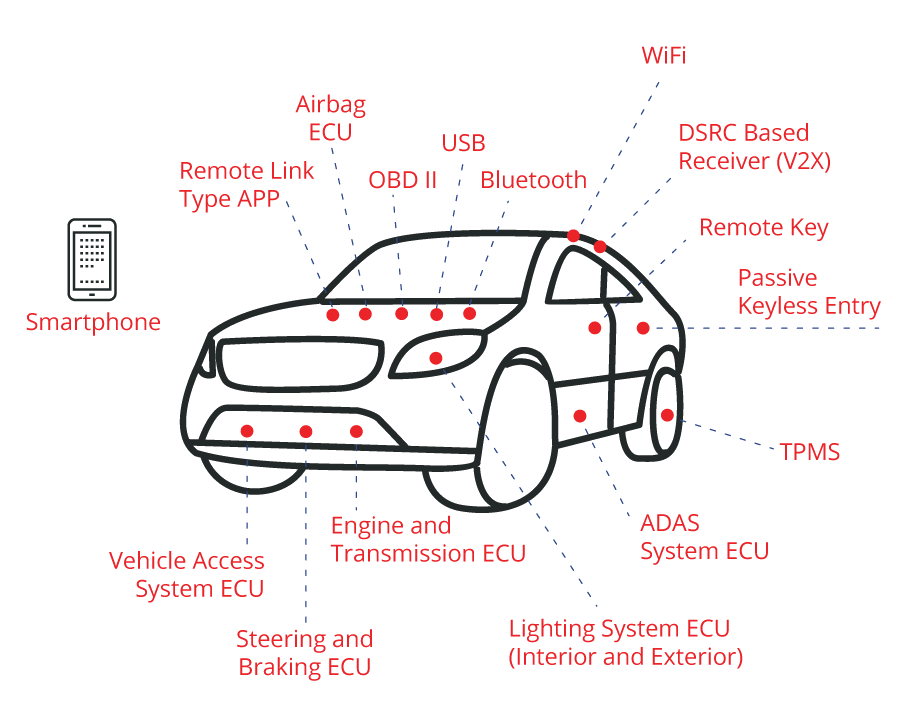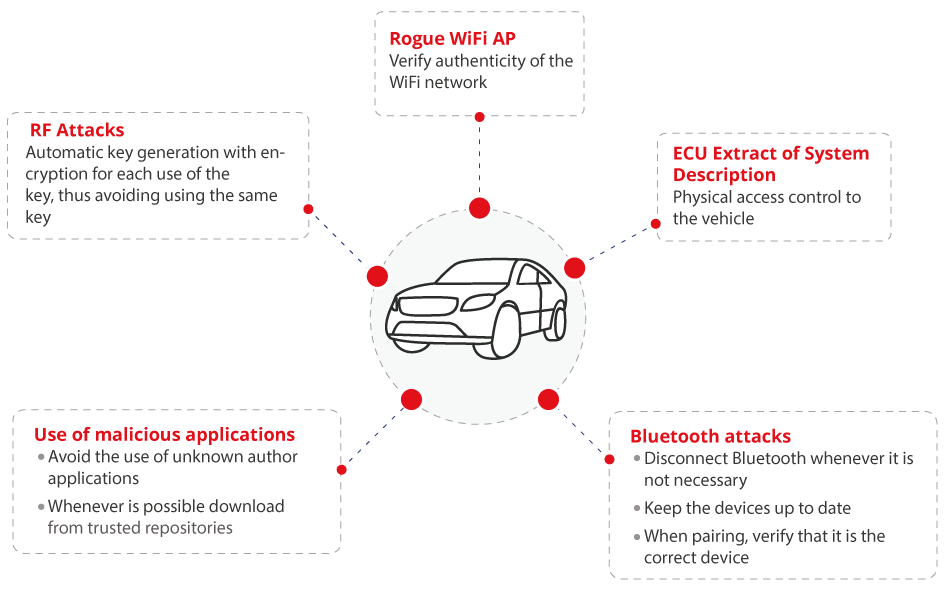Smart cars: are they prepared for threats?

Over time, technology has been evolving, making use of new means of communication. The automotive industry has incorporated these new technologies in order to carry out tasks as simple as starting the car, opening the door or turning on the lights. Nonetheless, these new systems are not perfect and, on many occasions, they have some security deficiencies that may be exploited by attackers.
For example, the use of NFC technology for both charging mobile devices and opening, closing and starting a vehicle from a smartphone or another specific device working at the same frequency that’s a short distance away and where the way to get the handshake is quickly obtained, which would make it possible to take control of the vehicle.
In our article Smart cars security review specifications were defined for the motoring world in order to address aspects related to the communications between the vehicle and the outside, attacks on the TPMS (Tire-Pressure Monitoring System) and a vision of advanced automotive technology.
This article will focus on the most commonly used protocols and technologies, together with the possible attack vectors and countermeasures that may be applied in order to mitigate or resolve problems concerning cybersecurity.
Communication protocols
In terms of communication protocols used by vehicles, it is worth highlighting the two most widely used in this sector, the CAN (Controller Area Network) Bus and the LIN (Local Interconnect Network) Bus.
- CAN Bus: it is the most widely used protocol worldwide and can be classified according to its speed; high speed, up to 1 Mbit/s, or low speed, fault-tolerant up to 125 kbit/s. While it is one of the most commonly used, it is quite an old protocol and has quite a lot of proven deficiencies and vulnerabilities.
- LIN Bus: it is an extension of CAN Bus, which has certain limitations, such as a maximum speed of 20 kbits/s, making its data transfer considerably less than that of the CAN Bus.
- Other protocols used: Ethernet, FlexRay, Immobilizers, MOST (Media Oriented Systems Transport), etc.
Most commonly used technologies
The majority of new vehicle models have different technologies that can pose new security risks and are considered to be possible attack vectors.
- Mobile devices: on these devices, security lies in the device itself and its protocols. In other words, a series of security measures would need to be applied, such as encrypting communications, secure passwords, etc., because if a mobile device is compromised, the attacker could interact with the vehicle.
- WiFi technology: vehicles with the capacity to create WiFi networks and become access points for devices may be affected by all the possible attacks against these types of networks.
- Remote control: various actions may be completed from the device, such as opening or closing doors, starting the car, turning the lights on... An attacker could exploit this technology’s shortcomings in order to take control of the vehicle, being able to do the same actions as with the original device.
- TPMS control system: this system is responsible for monitoring tire pressure and alerting the driver in the event that the tires do not have sufficient pressure levels. A possible attack on the vehicle could exploit such technology and could be able to provoke spoofed activation, packet spoofing or vehicle tracking.
- Infotainment system: the screen, as well as the input devices and applications to connect the vehicle and the mobile device, such as Apple-Car or Android Auto, can enable the control of the vehicle’s console.
- USB ports: normally used to connect devices, although they may be used maliciously for code execution or app installation.
- Bluetooth technology: used to connect mobile phones, GPS devices, hands-free, etc. It has the same particular vulnerabilities as WiFi.
- OBD-II (On Board Diagnostics) port: it is a system that is used to check all of the vehicle’s sensors. This port can be used by an attacker in order to extract information or to inject malicious code to modify the vehicle’s operation.

- Technologies currently used by smart cars. Source: UNAM. -
Smart cars have a lot of devices to make it easier for the driver to control the vehicle, such as cameras, sensors and different elements that allow it to interact with its surroundings. The communications used by these devices may also pose security risks. These are:
- V2V (Vehicle to Vehicle): The information being generated by a vehicle will be sent to another vehicle (i.e. controlling the distance from the rest of vehicles).
- V2I (Vehicle to Infrastructure): The information being generated by a vehicle will be sent to an infrastructure (the vehicle interacts with the environment, can receive information about traffic, condition of the pavement, etc.).
- V2G (Vehicle to Grid): A vehicle communicates with the electric grid (informing about the current battery status or that it needs to be charged).
Attack vectors in smart cars and how to prevent them
The sum of all of the aforementioned technology and communications used may converge in a series of attack vectors used by criminals.
We will take a look at some and how to address them:
- Rogue AP for WiFi communications. The main objective of this type of attack could be the theft of information of the vehicle’s occupants to later be able to carry out malicious actions to exploit the information and carry out social engineering attacks. This type of technique is known as Rogue Access Point. It creates a WiFi network to try and impersonate the original and be able to redirect all of the traffic through the attacker. To try and prevent this type of attack, when connecting the device to WiFi, it is important that the user checks that the network is the car’s original network and not a trap network. In addition to this type of attack, there are other methods they could take advantage of, such as man-in-the-middle attacks, MAC spoofing and eavesdropping. These types of techniques are discussed in the WiFi network security guide.
- Manipulating the ECU (Engine Control Unit) information. This type of attack is typically carried out through the CAN protocol, connecting via the OBD-II device. Once the attacker has access to such port, and after injecting and executing the malicious code, they would be able to extract and analyze information from the ECU. This could cause a disruption in the correct operation of the vehicle, so a possible countermeasure could be to control who has access to the vehicle, thus preventing attackers from physically accessing it. Were an attacker to gain access, they could exploit such vulnerability in order to create a backdoor and connect via both WiFi and Bluetooth. Access to and manipulation of the ECU could cause alterations in measurements taken, attacks on the TPMS system, generation of errors or codes that the car interprets as dangerous to its functioning.
- Bluetooth attacks, for example, may allow for sensitive data to be stolen the person that pairs their device. A recommendation or measure to protect our devices from attacks that exploit their vulnerabilities is to disconnect Bluetooth whenever it is not needed and have devices updated with the latest available version. Furthermore, there are attacks that, by exploiting Bluetooth, could make it possible to deceive users at the time of establishing the connection and obtaining data about the device. For this reason, in the pairing process, it should be clear that the device users are trying to connect to it is really that device.
- Use of malicious applications that may be found and downloaded from untrustworthy repositories. Do not use applications from unknown developers, always download from trusted repositories, such as the Google Play Store or the App Store, or on the manufacturer’s official page.
- RF attacks. Depending on the model of the vehicle and according the algorithm it has for generating keys, these may be stolen and subsequently used to open, close or start the car. One of the proposed solutions for this vulnerability is to automatically generate encrypted keys each time the key is used, thus preventing the same keys from being reused.

- Vectors attacking smart vehicles and countermeasures. Source: Cyber Startup Observatory. -
Conclusions
The number of vehicles that include this type of technology is growing every day, and they adapt to new advances, such as 5G or artificial intelligence, which are great improvements but they could broaden the range of attacks. As we have seen, although they are new vehicles their security is not perfect; they still inherit many vulnerabilities from the already established technologies in the automotive industry.
For large automotive companies, cybersecurity continues to be an ongoing issue and an area for improvement. Some manufacturers are committed to and taking steps towards solving these problems by investing in both technology and security, striving to create the most secure vehicles possible.









